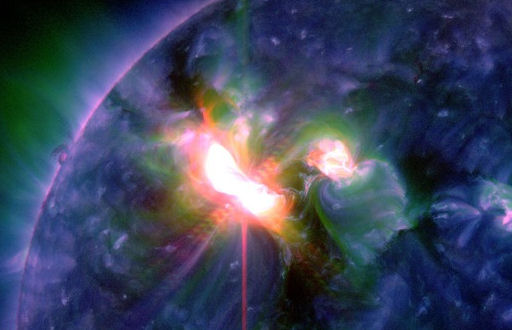GEOMAGNETIC STORM: Polar geomagnetic storms are underway following the arrival of a coronal mass ejection (CME) on March 7th at approximately 0400 UT. High-latitude sky watchers should be alert for auroras. Aurora alerts: text, phone.
Shortly after the CME impact, a burst of Northern Lights appeared over the US-Canadian border. Shawn Malone photographed the display from the shores of Lake Superior:
"I was lucky to catch this brilliant outburst of aurora activity that was very active for close to an hour," says Malone, who has also made a time-lapse video of the display. "The aurora had no problem shining through the moonlit skies."
more images: from Eric Frigon of Banff National Park , Alberta, Canada; from John Welling of Ashland,Wisconsin; from Justin Phillips of New Auburn, Wisconsin
MAJOR SOLAR FLARE: Big sunspot AR1429 has unleashed another major flare. This one is the strongest yet, an X5-class eruption on March 7th at 00:28 UT. NASA's Solar Dynamics Observatory recorded the extreme UV flash:
This eruption hurled a bright CME into space, shown here in a movie from the Solar and Heliospheric Observatory. Although the CME is not squarely Earth-directed, it appears direct enough to deliver a glancing blow to our planet's magnetic field on March 8-9. This would add to the magnetic unrest already underway at high latitudes.
The flare also accelerated energetic protons toward Earth, triggering an S3-class solar radiation storm, in progress. Such a storm is mainly a nuisance to satellites, causing occasional reboots of onboard computers and adding noise to imaging systems. Solar flare alerts: text, phone.

![]()
Solar wind
speed: 287.1 km/sec
density: 1.7 protons/cm3
explanation | more data
Updated: Today at 1448 UT
![]()
X-ray Solar Flares
6-hr max: X5 0028 UT Mar07
24-hr: X5 0028 UT Mar07
explanation | more data
Updated: Today at: 1600 UT
![]()
![]()
![]()
Daily Sun: 07 Mar 12
![]()
![]()
Big sunspot 1429 poses a continued threat for X-class solar flares. Credit: SDO/HMI
![]()
![]()
![]()
Sunspot number: 109
What is the sunspot number?
Updated 06 Mar 2012
Spotless Days
Current Stretch: 0 days
2012 total: 0 days (0%)
2011 total: 2 days (<1%)
2010 total: 51 days (14%)
2009 total: 260 days (71%)
Since 2004: 821 days
Typical Solar Min: 486 days
Updated 06 Mar 2012
The Radio Sun
10.7 cm flux: 138 sfu
explanation | more data
Updated 06 Mar 2012
![]()
![]()
![]()
Current Auroral Oval:
![]()
Switch to: Europe, USA, New Zealand, Antarctica
Credit: NOAA/POES
![]()
![]()
![]()
Planetary K-index
Now: Kp= 6 storm
24-hr max: Kp= 6 storm
explanation | more data
![]()
Interplanetary Mag. Field
Btotal: 10.2 nT
Bz: 3.1 nT north
explanation | more data
Updated: Today at 1617 UT
![]()
![]()
![]()
Coronal Holes: 07 Mar 12
![]()
![]()
A solar wind stream flowing from this coronal hole could reach Earth as early as March 8-9. Credit: SDO/AIA.






